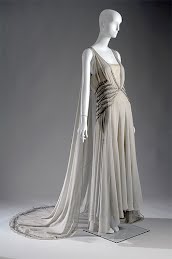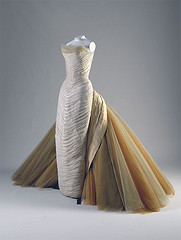Valentino on socializing
"Darling, at my age, I don't 'hang out.' I go to dinner."
-Fashion designer Valentino Garavani, in an interview in the April 2009 issue of InStyle (I picked up an old issue at the salon yesterday) in response to the question, "Where do you hang out in London?"
Love it. And even though he's got more than 50 years on me, I'd probably answer the exact same way.
-Fashion designer Valentino Garavani, in an interview in the April 2009 issue of InStyle (I picked up an old issue at the salon yesterday) in response to the question, "Where do you hang out in London?"
Love it. And even though he's got more than 50 years on me, I'd probably answer the exact same way.
Chic Chicago
I went to Chicago for the first time last week to visit my sister Elycia. It was an amazing trip, with way too many good things to blog about-- but a highlight was going to the Chicago History Museum.
HEY! Before you yawn and navigate away from this page, hear me out. This museum was awesome—small enough to be digestible, and full enough to be fascinating. The permanent collection includes the bed in which Abraham Lincoln died and an original waitress’ outfit from the first Playboy Club—dangerous AND sexy!
I particularly loved the “Chic Chicago” exhibit, which runs through July 26th 2009. It’s a collection of more than 60 couture outfits worn by Chicago society women from 1861 to 2004, and I would highly recommend it to anyone, regardless of his or her interest in fashion. It's a remarkably well put-together exhibit, and chock full of interesting information about the outfits on display and the women who wore them.

A gown designed by Madeleine Vionnet; worn by Mrs. Potter Palmer II when she was presented to the Queen of England in 1938.

A gown (that weighs 17 pounds!) designed by Charles James and known as the "Butterfly"; Worn by Mrs. John V. Farwell III in 1954.
The coolest part about Chic Chicago was the installation's design: The gallery walls had large photos of Chicago’s factories and slaughterhouses with superimposed quotations from prominent 19th and 20th century writers about the seedy, gritty nature of the city. Basically, the exhibit's organizers acknowledged that the enormous wealth that makes couture clothes available to certain people is often built on the backs of others who aren’t living in such charmed environs. I thought that it was a brave and very responsible way to frame the exhibit.
We weren't allowed to take photos in the gallery, but I found a couple from the exhibit's opening soiree posted online (here and here you can see the photos and quotations I mentioned.) I wonder if the socialites in the foreground of these photos were inspired at all by the exhibit's background to think about where their own clothes came from?
HEY! Before you yawn and navigate away from this page, hear me out. This museum was awesome—small enough to be digestible, and full enough to be fascinating. The permanent collection includes the bed in which Abraham Lincoln died and an original waitress’ outfit from the first Playboy Club—dangerous AND sexy!
I particularly loved the “Chic Chicago” exhibit, which runs through July 26th 2009. It’s a collection of more than 60 couture outfits worn by Chicago society women from 1861 to 2004, and I would highly recommend it to anyone, regardless of his or her interest in fashion. It's a remarkably well put-together exhibit, and chock full of interesting information about the outfits on display and the women who wore them.

A gown designed by Madeleine Vionnet; worn by Mrs. Potter Palmer II when she was presented to the Queen of England in 1938.

A gown (that weighs 17 pounds!) designed by Charles James and known as the "Butterfly"; Worn by Mrs. John V. Farwell III in 1954.
We weren't allowed to take photos in the gallery, but I found a couple from the exhibit's opening soiree posted online (here and here you can see the photos and quotations I mentioned.) I wonder if the socialites in the foreground of these photos were inspired at all by the exhibit's background to think about where their own clothes came from?
On fast fashion and good buys
My Aunt Linda likes to tell a cute story of the time that she babysat my sister and me and brought us with her to a department store. We were each between 3 and 5 years old, obviously too young to really evaluate prices-- but we spent the whole trip toddling around the racks, looking at price tag after price tag disapprovingly, clicking our tongues and saying: "Too much. Too much." We were parroting the behavior we'd witnessed in our mom-- a very savvy shopper, never fazed by marketing and never accepting less than a "good buy."
Cut to the present day: I've just become a wage-earning adult in the media-saturated, post-Sex and the City world, where womanhood and femininity are ostensibly defined by buying $150 designer jeans, "investing" in a $12,000 Hermes handbag, and wearing ridiculously overpriced Victoria's Secret "lingerie." Thanks to my mom, for the most part, I'm just not buying it.
And I'm not alone: Last week, England's House of Lords published a report criticizing the environmental and societal effects of the present "culture of 'fast fashion" in which consumers "dispose of clothes which have only been worn a few times in favour of new, cheap garments which themselves will also go out of fashion and be discarded within a matter of months."
It's terrific that the Lords are confronting this issue-- but I'd disagree with the interpretation that patronizing stores like H&M and Forever 21 should as a rule be eschewed in favor of buying from more "quality" fashion houses. The reality is that today, fast fashion happens equally at the highest and lowest ends of the market.
The majority of stuff sold in mainstream stores is fleetingly trendy rubbish, at all price ranges. Frankly, if I'm going to buy a cheaply-made imported garment, I'd rather spend $20 at H&M instead of $400 at Barney's. I know the workers are treated poorly and paid very low wages, so I'd prefer to line the pockets of the executives overseeing it all as little as possible, you know?
But that is only a lesser-of-two-evils approach. More and more, I'm trying to get away from buying new clothes at all, just because it's such a flawed system and the products are such crap. I like the concept of always shopping, but rarely buying-- continuously being on the lookout for nice pieces so that I don't have to buy fast fashion out of desperation. This idea seems very French to me-- in the aforementioned Elegance book, Madame Dariaux cautions the reader to "never be seduced by anything that isn't first-rate."
It's not easy, but Jezebel.com writer Sadie Stein is now "three weeks clean" from fast fashion, and I like her logic: "The small after-work of pleasure of a cheap top... is something we've become accustomed to very quickly -—such a thing would have been unheard-of a few generations ago -—and I'm guessing that, together, we can weather the withdrawal." Anyone else in?
Cut to the present day: I've just become a wage-earning adult in the media-saturated, post-Sex and the City world, where womanhood and femininity are ostensibly defined by buying $150 designer jeans, "investing" in a $12,000 Hermes handbag, and wearing ridiculously overpriced Victoria's Secret "lingerie." Thanks to my mom, for the most part, I'm just not buying it.
And I'm not alone: Last week, England's House of Lords published a report criticizing the environmental and societal effects of the present "culture of 'fast fashion" in which consumers "dispose of clothes which have only been worn a few times in favour of new, cheap garments which themselves will also go out of fashion and be discarded within a matter of months."
It's terrific that the Lords are confronting this issue-- but I'd disagree with the interpretation that patronizing stores like H&M and Forever 21 should as a rule be eschewed in favor of buying from more "quality" fashion houses. The reality is that today, fast fashion happens equally at the highest and lowest ends of the market.
The majority of stuff sold in mainstream stores is fleetingly trendy rubbish, at all price ranges. Frankly, if I'm going to buy a cheaply-made imported garment, I'd rather spend $20 at H&M instead of $400 at Barney's. I know the workers are treated poorly and paid very low wages, so I'd prefer to line the pockets of the executives overseeing it all as little as possible, you know?
But that is only a lesser-of-two-evils approach. More and more, I'm trying to get away from buying new clothes at all, just because it's such a flawed system and the products are such crap. I like the concept of always shopping, but rarely buying-- continuously being on the lookout for nice pieces so that I don't have to buy fast fashion out of desperation. This idea seems very French to me-- in the aforementioned Elegance book, Madame Dariaux cautions the reader to "never be seduced by anything that isn't first-rate."
It's not easy, but Jezebel.com writer Sadie Stein is now "three weeks clean" from fast fashion, and I like her logic: "The small after-work of pleasure of a cheap top... is something we've become accustomed to very quickly -—such a thing would have been unheard-of a few generations ago -—and I'm guessing that, together, we can weather the withdrawal." Anyone else in?